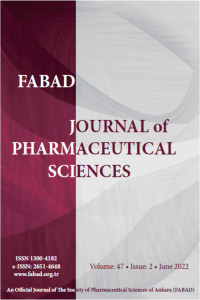A Cosmetic Nanoemulsion Against Seborrheic Dermatitis: Development, Characterization and Effectiveness
Öz
In this study, it was aimed to develop a topically applicable
nanoemulsion (NE) that is expected to have an ameliorating effect in
seborrheic dermatitis (SD). The main purpose of the formulation is to
eliminate the disease factor, to repair the damage caused by the disease
on the skin and to smooth the skin appearance by moisturization. For
this reason, in vitro antimicrobial effect and in vivo effectiveness of
the formulation were tested. For this aim; essential oils from tea tree,
sage, cinnamon, oregano; extracts from Aloe vera, colloidal oatmeal,
liquorice; vegetable oils from grape seed and sesame, and honey were
used in a NE formulation. The NEs were prepared by ultrasonication
method. Preliminary stability tests were applied to all formulations
and then, pH, conductivity, viscosity, average droplet size,
polydispersity index (PDI), and zeta potential measurements were
taken on the selected NEs for 3 months. Finally, the antimicrobial
effect and in vivo effectiveness of the optimum NE were tested. The
average droplet size, PDI, and zeta potential value of the optimum
formulation (F6P2) were 108.40 ± 0.90 nm, 0.195 ± 0.07, and
-21.40 ± 1.45 mV, respectively. As a result, the moisture content of
the skin increased significantly (p < 0.001), the sebum and redness
values significantly decreased (p = 0.008 and 0.001, respectively)
and there was no significant change in the pH of the volunteers’ skin.
Accordingly, it can be concluded that the optimum NE formulation
developed in this study may be beneficial as a supplement for patients
with SD.
Anahtar Kelimeler
Seborrheic dermatitis nanoemulsion herbal cosmetic efficacy tests essential oils plant extracts vegetable oils honey
Kaynakça
- Abismaıl, B., Canselier, J. P., Wilhelm, A. M., Delmas, H., & Gourdon, C. (1999). Emulsification by ultrasound:drop size distribution and stability. Ultrasonics Sonochemistry, 6(1-2), 75-83.
Öz
Kaynakça
- Abismaıl, B., Canselier, J. P., Wilhelm, A. M., Delmas, H., & Gourdon, C. (1999). Emulsification by ultrasound:drop size distribution and stability. Ultrasonics Sonochemistry, 6(1-2), 75-83.
Ayrıntılar
| Birincil Dil | İngilizce |
|---|---|
| Konular | Eczacılık ve İlaç Bilimleri |
| Bölüm | Araştırma Makalesi |
| Yazarlar | |
| Yayımlanma Tarihi | 1 Ağustos 2022 |
| Gönderilme Tarihi | 7 Şubat 2022 |
| Yayımlandığı Sayı | Yıl 2022 Cilt: 47 Sayı: 2 |


